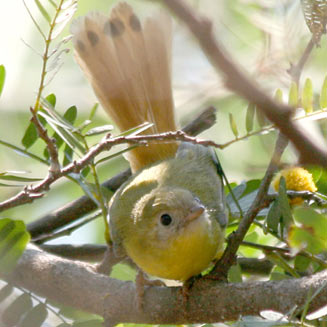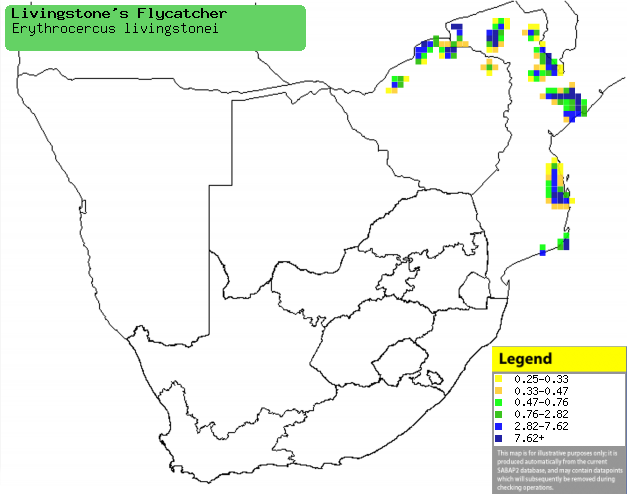|
Erythrocercus livingstonei
(Livingstone's flycatcher)
RooistertvlieŽvanger [Afrikaans]; Palalithupa [South
Sotho]; Grijskop-elfmonarch [Dutch]; Mignard enchanteur [French];
Elfenschnšpper [German]; Papa-moscas de Livingstone [Portuguese]
Life
> Eukaryotes >
Opisthokonta
> Metazoa (animals) >
Bilateria >
Deuterostomia > Chordata >
Craniata > Vertebrata (vertebrates) > Gnathostomata (jawed
vertebrates) > Teleostomi (teleost fish) > Osteichthyes (bony fish) > Class:
Sarcopterygii (lobe-finned
fish) > Stegocephalia (terrestrial
vertebrates) > Tetrapoda
(four-legged vertebrates) > Reptiliomorpha > Amniota >
Reptilia (reptiles) >
Romeriida > Diapsida > Archosauromorpha > Archosauria >
Dinosauria
(dinosaurs) > Saurischia > Theropoda (bipedal predatory dinosaurs) >
Coelurosauria > Maniraptora > Aves
(birds) > Order: Passeriformes
> Family: Sylviidae
 |
|
|
Livingstone's flycatcher, Liwonde, Malawi. [photo
© Dave Appleton, www.gobirding.eu] |
|
Distribution and habitat
Occurs from Tanzania, southern Malawi and northern
Mozambique to southern Africa. Here it is locally common in patches across
Mozambique and northern Zimbabwe. It generally prefers to live in the canopy of
riverine forest or woodlands of Acacia, miombo (Brachystegia),
mohobobo (Uapaca) or Mopane (Colosphermum mopane) trees.
|
 |
|
Distribution of Livingstone's flycatcher in southern Africa,
based on statistical smoothing of the records from first SA Bird Atlas
Project (©
Animal Demography unit, University of
Cape Town; smoothing by Birgit Erni and Francesca Little). Colours range
from dark blue (most common) through to yellow (least common). |
Food
Its diet is little known, but is thought to consist mostly
of insects. It often forages in groups, actively searching for prey in the
foliage and undergrowth of the woodland. Every 20-30 minutes they take a break
to rest, preening themselves and other members of the group.
Breeding
- The nest is unique among southern African flycatcher nests, as it is a
ball or oval with a side entrance, built of layers of dead leaves secured
with spider's web. It is typically deep in the tree canopy amongst leaves
and seed pods, often extremely camouflaged and difficult to see.
- Egg-laying has only been recorded 7 times in southern Africa, all of
which where recorded during January and February.
- It lays 2-3 eggs, which hatch into chicks that are fed by both parents
and possibly other group members.
Threats
Not threatened.
References
-
Hockey PAR, Dean WRJ and Ryan PG 2005. Roberts
- Birds of southern Africa, VIIth ed. The Trustees of the John Voelcker
Bird Book Fund, Cape Town.
-
Harrison, J.A., Allan, D.G., Underhill, L.G., Herremans, M.,
Tree. A.J., Parker, V. & Brown, C.J. (eds). 1997. The atlas of southern
African birds. Vol. 2: Passerines. BirdLife South Africa, Johannesburg.
|
